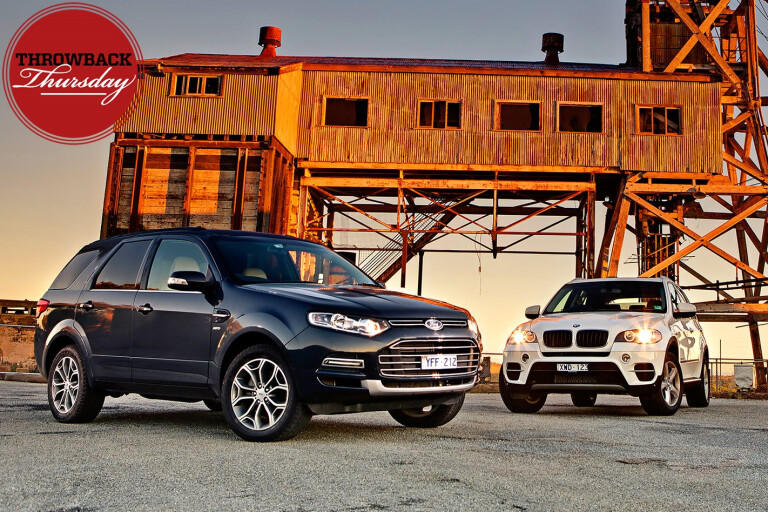
First published in the May 2011 issue of Wheels magazine, Australia's best car mag since 1953.
We’ve been out here to Cameron Corner before, but never in an Aussie-built diesel SUV … let alone one with the ability to stand comparison with a BMW $30K more expensive.
Can't wait to see the final scores? Jump to the verdict now.
NEW Ford Territory means a trip to The Corner Store. The one at Cameron Corner, to be specific, in outback Australia, where NSW, QLD and SA collide. It swelters between the stony heat of the Strzelecki Desert and the rolling sand dunes of the Sturt National Park. Temperatures hit 50 degrees in summer and zero overnight in winter. It’s 1500km from Melbourne, a bit less from Sydney, and is the only pub, fuel and food stop for 150km. This is not just cattle country; it’s also gas country – the Moomba oil and gas fields supply 80 percent of Melbourne and Sydney households.
Wheels pits Aussie cars against the outback whenever a local car maker produces a significant new model. Mega road-trips covering thousands of diverse kilometres, many of them rutted and corrugated dirt lifelines. We’ve taken most watershed Falcons and Commodores, Magnas, Avalons, Aurions and Camrys to the outback. I first took the SX Territory to The Corner in 2004. Seven years later, I’m going back in the SZ.
No Australian-made vehicle – in theory – has ever been so suited to our immense country, nor so fundamentally prepared for life outside the urban sprawl. A quicker-thinking all-wheel-drive system and a frugal turbo-diesel engine are two of the new-look SZ’s many updates. There’s a new electric steering system and front subframe, suspension modifications, economy improvements for the petrol in-line six, and a fresh interior with new multi-function infotainment centre.
 But the Australian outback has a surprise in store. Normally, Back o’ Bourke is all red dirt and stony landscapes shimmering in the heat haze. This time Mother Nature is keen to jump on the ‘green’ bandwagon, and huge rains in the last 18 months have brought life to the arid interior. The barren red desert is verdant, greener than an environmentalist’s hemp underwear. Once-dry lakes are full, and rivers that haven’t flowed in decades cut life-giving swathes across the land. Wildlife abounds.
But the Australian outback has a surprise in store. Normally, Back o’ Bourke is all red dirt and stony landscapes shimmering in the heat haze. This time Mother Nature is keen to jump on the ‘green’ bandwagon, and huge rains in the last 18 months have brought life to the arid interior. The barren red desert is verdant, greener than an environmentalist’s hemp underwear. Once-dry lakes are full, and rivers that haven’t flowed in decades cut life-giving swathes across the land. Wildlife abounds.
It’s raining as we leave Melbourne, me in the Territory, Wheels’ go-to man ‘Cletus’ in the BMW and new-boy Harry in my SS V Ute long-termer. Ostensibly the ute is a support vehicle, dubiously credentialed for desert duty. I’m looking forward to unleashing its 6.0-litre V8 on the bone-dry Waka claypan between Tibooburra and the Corner, just like Holden did for the Thunderstruck Ute TV ad for the VU SS. Obviously the ute’s not an all-wheel-drive diesel, so it’s not a player in this comparo. Strange, then, how my support crew constantly fought for its keys once we reached dirt…
The BMW X5 is a European yardstick for Ford’s Aussie diesel. Ford benchmarked the Territory against it; so will we. The $92,100 xDrive 30d’s turbocharged 3.0-litre is the finest oil-burning six around, proof that diesels are not just for economy. It accelerates with gusto thanks to 180kW and 540Nm, and is not without aural appeal, though diesel clatter dominates above 3500rpm. Add a new ZF eight-speed automatic transmission and the X5 is a relatively rapid hauler, but it’s constantly shuffling gears to keep the engine on the boil.
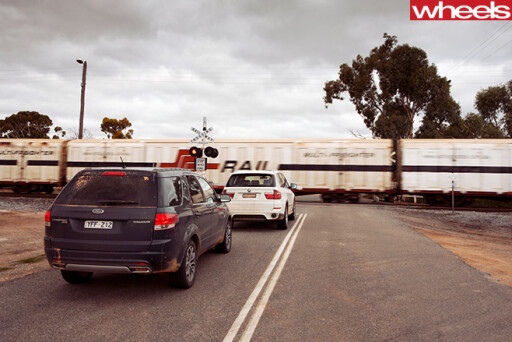 The Territory is not so well-endowed, nor so heavy on the hip pocket. The Titanium model replaces the Ghia atop the range. The rear-drive petrol six costs $54,990, to which our test car added $3250 for the diesel and $5K for all-wheel drive. A two-seater third row is a no-cost option in the Titanium; it adds $3200 to the X5 (including mandatory self-levelling rear suspension, otherwise a $2200 option.) The Territory’s 2.7-litre Duratorq V6 turbo-diesel is not new, but is well pedigreed, having served in Jaguars, Land Rovers, Peugeots and Citroëns. Ford Australia selected the single-turbo version (which still powers the entry-level Discovery) because it’s cheaper to manufacture and therefore cheaper to sell. Its 140kW and 440Nm outputs are no match on paper for those of the X5, but should be adequate shifting our only home-grown SUV.
The Territory is not so well-endowed, nor so heavy on the hip pocket. The Titanium model replaces the Ghia atop the range. The rear-drive petrol six costs $54,990, to which our test car added $3250 for the diesel and $5K for all-wheel drive. A two-seater third row is a no-cost option in the Titanium; it adds $3200 to the X5 (including mandatory self-levelling rear suspension, otherwise a $2200 option.) The Territory’s 2.7-litre Duratorq V6 turbo-diesel is not new, but is well pedigreed, having served in Jaguars, Land Rovers, Peugeots and Citroëns. Ford Australia selected the single-turbo version (which still powers the entry-level Discovery) because it’s cheaper to manufacture and therefore cheaper to sell. Its 140kW and 440Nm outputs are no match on paper for those of the X5, but should be adequate shifting our only home-grown SUV.
The long straights between Melbourne and Mildura on the Calder Highway give opportunity to cruise in both. It’s a credit to Ford’s NVH engineers how quiet the Territory TDCi’s Duratorq V6 is. At 110km/h it’s ticking along at 1950rpm, the engine’s point of peak torque. The engine note is distant and subdued, quieter than the BMW’s. The Territory’s also less susceptible to wind noise and isolates occupants better from tyre rumble. Surprised? Me too, but it’s true. The Territory’s new (Ford FG Falcon) dashboard is classy; the best of any Australian car. We’ve made much of the Territory’s versatile interior before, with its myriad storage options. They’re all still there, contributing to a more welcoming environment than BMW’s dark and less practical interior. Territory’s seats also quickly assert their superiority. Softer than the BMW’s planks, they nonetheless provide the requisite support.
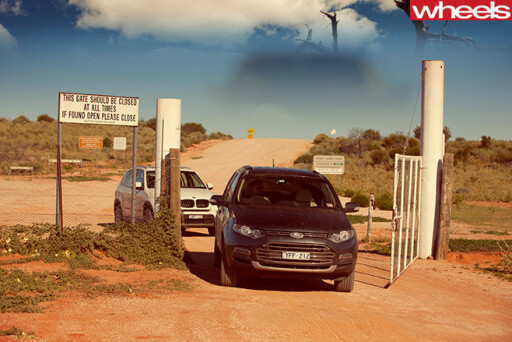 The Ford scores another win in ride composure. The roller-coaster Calder Highway around Ouyen is as lumpy as a mafia carpet. Yet the Territory rides this roly-poly bitumen with compliance, despite stiffer springs front and rear. The firmly-sprung BMW pogoes constantly, annoyingly. The X5’s stiffer legs should bring handling advantages on winding roads, but there are none in north-western Victoria. There’s plenty of evidence of the terrible floods that ravaged this region in February, though. Rotting clumps of vegetation hang limply on wire fences, abandoned there by surging waters. The road hasn’t escaped damage. Edges have crumbled, sometimes eating halfway into the lane, and there are plenty of potholes and craters. We pass half a dozen road gangs between Wedderburn and Mildura, and a handful more locations where the road waits to be repaired, witches hats warning of bitumen completely washed away and sharp edges exposed ready to puncture the tyres of the unwary. Braking for, and accelerating away from each plays to the BMW’s strengths. This powertrain – new to the X5 in 2010 – is way beyond Territory’s 2004-vintage donk. It responds better to the throttle and leaps away from rest. It has more strength in each gear and is quicker to kick down if even more is needed.
The Ford scores another win in ride composure. The roller-coaster Calder Highway around Ouyen is as lumpy as a mafia carpet. Yet the Territory rides this roly-poly bitumen with compliance, despite stiffer springs front and rear. The firmly-sprung BMW pogoes constantly, annoyingly. The X5’s stiffer legs should bring handling advantages on winding roads, but there are none in north-western Victoria. There’s plenty of evidence of the terrible floods that ravaged this region in February, though. Rotting clumps of vegetation hang limply on wire fences, abandoned there by surging waters. The road hasn’t escaped damage. Edges have crumbled, sometimes eating halfway into the lane, and there are plenty of potholes and craters. We pass half a dozen road gangs between Wedderburn and Mildura, and a handful more locations where the road waits to be repaired, witches hats warning of bitumen completely washed away and sharp edges exposed ready to puncture the tyres of the unwary. Braking for, and accelerating away from each plays to the BMW’s strengths. This powertrain – new to the X5 in 2010 – is way beyond Territory’s 2004-vintage donk. It responds better to the throttle and leaps away from rest. It has more strength in each gear and is quicker to kick down if even more is needed.
 Trip computers in both claim around 9L/100km since Melbourne, not bad for big, bluff-nosed 2.1-tonne family wagons. However, that’s far from the Territory’s 6.5L/100km highway ADR that Ford uses to substantiate its ‘Melbourne to Sydney on a tank’ boast. To experiment, I lower the speed while watching the trip computer’s instant fuel reading. At 80km/h it stays consistently below seven. That means the 900km Hume Highway trip would take a little over 11 hours compared with eight at the Hume’s 110km/h limit. Clearly, ADR 81/02 is rubbish.
Trip computers in both claim around 9L/100km since Melbourne, not bad for big, bluff-nosed 2.1-tonne family wagons. However, that’s far from the Territory’s 6.5L/100km highway ADR that Ford uses to substantiate its ‘Melbourne to Sydney on a tank’ boast. To experiment, I lower the speed while watching the trip computer’s instant fuel reading. At 80km/h it stays consistently below seven. That means the 900km Hume Highway trip would take a little over 11 hours compared with eight at the Hume’s 110km/h limit. Clearly, ADR 81/02 is rubbish.
The crumbling bitumen calls for more steering than usual on Victoria’s straightest road. Both cars have electric steer, which brings fuel consumption savings as it doesn’t need the engine for assistance. Both are arcade game light and lifeless at parking speeds – who needs feel at 5km/h? – yet firm up nicely on the move. The BMW’s quicker tiller is handicapped by the suspension, which tugs at the wheel over undulations. And when there’s 50km of undulations, that becomes tiring.
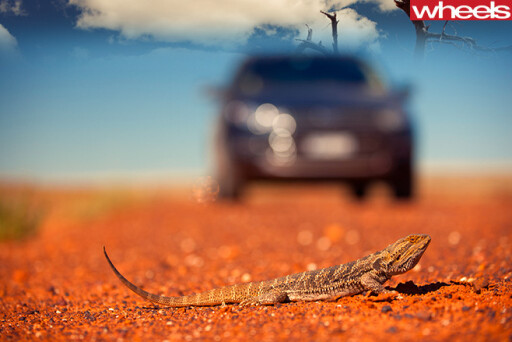 Ford’s engineers calibrated the Territory’s EPAS for Aussie roads, and it shows. It’s lighter at speed than the old hydraulic system, yet meaty enough to give decent feel. It also lacks the original Tezza’s on-centre reactivity, but the chassis still tracks beautifully across the rolling bitumen, and isn’t overly bothered by camber or crosswinds. Between that and the BMW’s ultra-taut ride, I’m reluctant to swap with Cletus. After stopping for fuel in Mildura, he snatches the Ford’s keys. To his chagrin the Silver City Highway to Broken Hill is far smoother than the crappy Calder.
Ford’s engineers calibrated the Territory’s EPAS for Aussie roads, and it shows. It’s lighter at speed than the old hydraulic system, yet meaty enough to give decent feel. It also lacks the original Tezza’s on-centre reactivity, but the chassis still tracks beautifully across the rolling bitumen, and isn’t overly bothered by camber or crosswinds. Between that and the BMW’s ultra-taut ride, I’m reluctant to swap with Cletus. After stopping for fuel in Mildura, he snatches the Ford’s keys. To his chagrin the Silver City Highway to Broken Hill is far smoother than the crappy Calder.
We consider not refuelling at Mildura, after driving 540km from Melbourne. The BMW claims its 85-litre tank still has enough fuel to reach Broken Hill, 300km north. The Territory’s 75-litre tank doesn’t. Running out of diesel in the Territory is not a big deal, Ford says. Its Bosch V9 engine management system – which brings rollover mitigation and engine torque drag control on trailing throttle – shuts off the high-pressure injectors before air infiltrates (as many new diesels do). So, theoretically, there’s no need to have the injectors professionally repressurised; just refuel and go. I tried to test that on the way home, but the Territory made the 30km to the petrol station after the trip computer claimed ‘0km to empty’. Trip computers are rubbish, too.
At Broken Hill somebody finally spots our new Territory. A bloke in a battered Landcruiser ute pulls alongside and winds down his window.
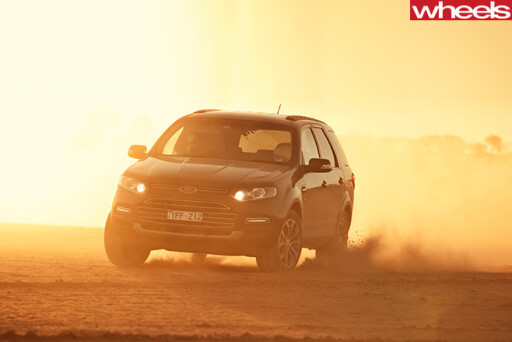 “Is that the new Territory?”
“Is that the new Territory?”
“Yep.”
With that, he drives off. Make of that what you will, but he was the only person in 2800km who showed the slightest interest in the Territory’s sharp new clothes. Personally, I think it looks more interesting, more sophisticated, than the chunky Tonka original.
The next morning we rise early for photography at one of Broken Hill’s derelict mines before hitting the supermarket for supplies. If all goes well we’ll be camping under the stars near Cameron Corner tonight. We brim the cars, and then fill ourselves with bacon and egg rolls from Charlotte’s on the main street. All agree it’s the best brekkie roll ever. It’s funny how leaving civilisation can make simple pleasures so profound.
North of Broken Hill the Silver City Highway alternates between bitumen and well-packed dirt when dry, and porridge when wet. Today it’s dry. I start in the Ford, having pilfered the keys back from Cletus. The engine’s not as authoritative as BMW’s benchmark, but it’s no lightweight. The Territory shows a liking for the long, languid bends that unfurl beneath the blue sky as we continue north, cruising at 100km/h and some, barrelling along at 2500rpm in sixth. The diesel’s gearbox is the ZF-based 6R80 torque-monster beefed up for the F-Series and Mustang, and it’s a decent shifter that slurs gently between ratios. Most of the time it works beautifully, if just a tad slowly, but can fumble first-to-second. On the rolling plains before Packsaddle it works better in Performance mode; more attentive to throttle inputs and in tune with my intentions.
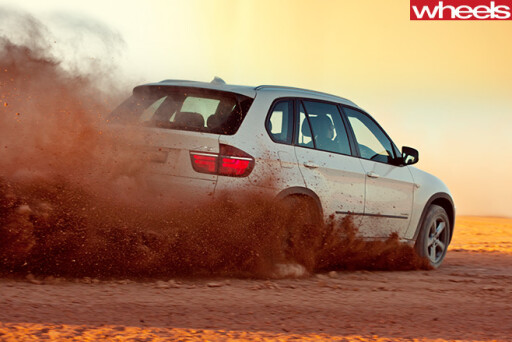 AWD models get a shorter final drive (3.46 compared to 3.23 in RWD) which doesn’t disguise the Duratorq’s lethargic throttle response off the line. The BMW takes ruthless advantage of the Ford’s drivetrain weakness when we stop for an impromptu drag race. The only rule: no preloading the throttle. On ‘Go!’ the BMW leaps forward with an alacrity many petrol cars would envy. It’s a car-length ahead before the Territory finally moves, ages after I’ve stomped the throttle. When the Ford hits 60km/h the BMW is four lengths clear. By 100km/h, enough is enough. The Duratorq engine has its strengths but performance isn’t one of them. BMW claims 0-100km/h in 7.6 seconds for the X5 30d; Ford doesn’t provide performance figures, but feels at least two seconds off-pace. Away from outback drag strips, the Territory’s lacklustre initial response is troublesome merging from a side street, or grabbing a gap in the next lane. It needs to be sharper.
AWD models get a shorter final drive (3.46 compared to 3.23 in RWD) which doesn’t disguise the Duratorq’s lethargic throttle response off the line. The BMW takes ruthless advantage of the Ford’s drivetrain weakness when we stop for an impromptu drag race. The only rule: no preloading the throttle. On ‘Go!’ the BMW leaps forward with an alacrity many petrol cars would envy. It’s a car-length ahead before the Territory finally moves, ages after I’ve stomped the throttle. When the Ford hits 60km/h the BMW is four lengths clear. By 100km/h, enough is enough. The Duratorq engine has its strengths but performance isn’t one of them. BMW claims 0-100km/h in 7.6 seconds for the X5 30d; Ford doesn’t provide performance figures, but feels at least two seconds off-pace. Away from outback drag strips, the Territory’s lacklustre initial response is troublesome merging from a side street, or grabbing a gap in the next lane. It needs to be sharper.
Catching the BMW on the dirt after our drag race proves impossible, despite the Territory’s improved dynamics. Cletus is using the BMW’s adept xDrive AWD system to masterfully obscure the road under clouds of dust, so I drop back for clean air. Time to trial the Territory’s new all-wheel-drive system on fast dirt. Where the old model made do with a full-time 38/62 split and used the ESC to control wheelspin, the new system uses a multi-clutch transfer case to vary torque front to rear. It’s fundamentally the same system as in the X5, and still relies on ESC to brake spinning wheels. It can also disengage the front axle when the car is idling to reduce vibrations.
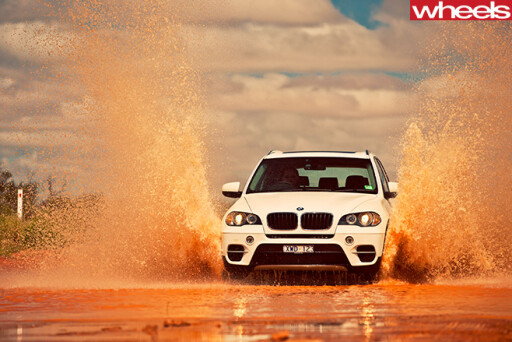 Early AWD systems lacked finesse apportioning torque between the axles, ending up in a push-pulling mess as torque shunted from an oversteering rear to provoke an understeering front. The Territory’s Borg-Warner system is not like this. In fact it’s hard to feel the transfer happening, even when deliberately provoking the Territory into a slide. Driven normally, it’s more planted in corners, and exhibits less bodyroll. It feels sharper through the steering, its reactions cleaner and more concise. What’s equally impressive is how supportive Territory’s ESC is. We’ve marvelled at the finesse of locally-developed ESC on dirt roads before, but it never ceases to amaze how well they work with – not against – an enthusiastic driver. Of course, to fully sample the new clutch-driven all-wheel drive meant disengaging the ESC. So I did. And was immediately reminded of what a brilliant job Ford engineers did teaching the Territory’s chassis to dance. This one’s even better, and a lot of fun to hurry along.
Early AWD systems lacked finesse apportioning torque between the axles, ending up in a push-pulling mess as torque shunted from an oversteering rear to provoke an understeering front. The Territory’s Borg-Warner system is not like this. In fact it’s hard to feel the transfer happening, even when deliberately provoking the Territory into a slide. Driven normally, it’s more planted in corners, and exhibits less bodyroll. It feels sharper through the steering, its reactions cleaner and more concise. What’s equally impressive is how supportive Territory’s ESC is. We’ve marvelled at the finesse of locally-developed ESC on dirt roads before, but it never ceases to amaze how well they work with – not against – an enthusiastic driver. Of course, to fully sample the new clutch-driven all-wheel drive meant disengaging the ESC. So I did. And was immediately reminded of what a brilliant job Ford engineers did teaching the Territory’s chassis to dance. This one’s even better, and a lot of fun to hurry along.
I want to turn left before Packsaddle towards The Veldt, and find Cletus and the BMW waiting dutifully. The plan is to spice things up using back-country tracks to follow the Dingo Fence to the Corner. We get 15km and five open-and-close gates in before spotting a VE Ute, beached on its belly at a dry river crossing.
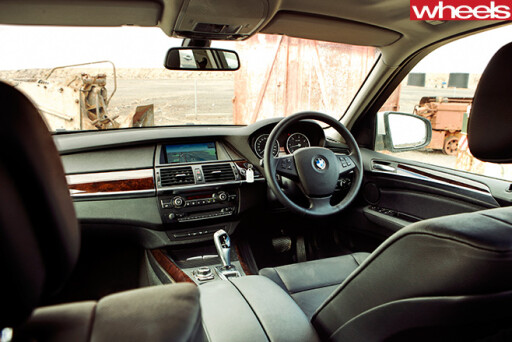 Mick and his mate had been out looking for lost sheep. I thought it a strange vehicle to use for such a venture, but say nothing because Mick is well over six foot and meaty like a country steak. He’s also drenched in sweat, and smiles tiredly as we amble up.
Mick and his mate had been out looking for lost sheep. I thought it a strange vehicle to use for such a venture, but say nothing because Mick is well over six foot and meaty like a country steak. He’s also drenched in sweat, and smiles tiredly as we amble up.
“You blokes couldn’t have been here a couple of hours ago, could ya?” he laments with a wry grin. “We’ve just finished jacking all the wheels up and putting rocks underneath.”
Hard work under a desert sun, I agree. What can we do to help?
“Get behind and give her a push as I drive out.”
Cletus, nice bloke that he is, suggests I push from right behind one of the wheels. But Mick’s finesse with the throttle undoes Cletus’s plan to see my face full of sand and rock, and the ute drives smoothly out of the creek bed. Mick gets out and thanks us. I thank him because if he couldn’t get through in a standard Ute then my lower SS V stands even less chance. Once he’s left, we run the Territory towards the bed out of curiosity, but it grades sand even sooner than Mick’s ute. Territory’s ground clearance is rubbish.
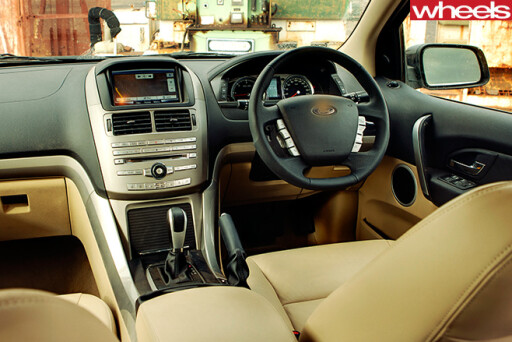 Back on the Silver City highway we motor into Tibooburra, pulling up at the servo. A bloke approaches. “Not going to The Corner, are you?”
Back on the Silver City highway we motor into Tibooburra, pulling up at the servo. A bloke approaches. “Not going to The Corner, are you?”
“Well, yes.”
“You’ll never get there in that,” he says, pointing at the support ute. “Road’s pretty cut up at the moment.”
“What about the Territory?” I ask.
“Which one’s that?” he says.
Has the SZ become part of the landscape already?
The Territory, it turns out, is the most confident on Cameron Corner’s 141km driveway. It handles the corrugations with ease, and exhibits an inherent chassis stability under brakes that the BMW fails to match. The BMW fidgets and skitters across loose rubble under power and squirms uncomfortably on sand under brakes. It’s a less than convincing exhibition of Germanic chassis stability, but I guess they don’t have a lot of outback roads round Munich.
We arrive at the claypan early afternoon, still time to reach The Corner and back by sunset. Before setting off we all hone our drifting skills in the SS V. Can’t make it rain, though. Holden Ute ads are rubbish.
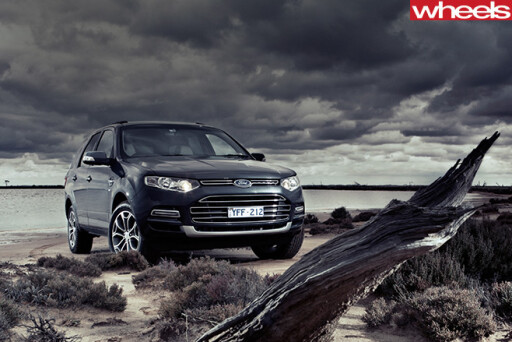 Back in the cars, we start climbing the many sand dunes that roll east from the Simpson Desert. The road is fairly well maintained so it isn’t like we are flirting with being bogged, but the softer surface does make the cars work harder. Every few hundred metres the road climbs 20 metres up a dune, then straight back down. At the right speed, it makes your stomach go light. The inherent nimbleness in both cars comes in handy as Cletus and I whip into broadsides to keep the cars on track.
Back in the cars, we start climbing the many sand dunes that roll east from the Simpson Desert. The road is fairly well maintained so it isn’t like we are flirting with being bogged, but the softer surface does make the cars work harder. Every few hundred metres the road climbs 20 metres up a dune, then straight back down. At the right speed, it makes your stomach go light. The inherent nimbleness in both cars comes in handy as Cletus and I whip into broadsides to keep the cars on track.
We make The Corner without fuss. A little too easily, if truth be told. I remember it being harder. Or perhaps cars really are getting better, even ‘soft-road’ SUVs like these. New owner Fenn Miller isn’t at all surprised to see our two urban SUVs and sports ute drive in. He says most vehicles can do it in the dry with the right driver. If it rains, however, “nothing’s going nowhere”. A final fill at Cameron leaves the two SUVs split by 0.1L/100km in the BMW’s favour – 10.3L vs 10.2L.
Sitting around the campfire later that night while Cletus charcoaled the snags, it’s apparent the Territory has scored an upset win. Its refinement and composure counted for more than the BMW’s luxury allure and brilliant drivetrain. Neither had struggled with the terrain, but the Territory was more confident and comfortable. As for value, that can be tricky when the prices are disparate. This time it’s not. The Territory is actually better equipped at $63K than the BMW is at $93K. I’m less enamoured by Territory Duratorq’s fuel figure. I expected better than 10s for a big-country drive, but the Territory’s number is competitive, even if the BMW does more with each drop.
So, Ford Territory beats BMW X5. Would the outcome be different if we threw some mountains into the equation? Anything’s possible, but unlikely. And anyway, the nearest decent climb is more than 1000km away, and the locals don’t like it when you drive up Uluru.
The Verdict
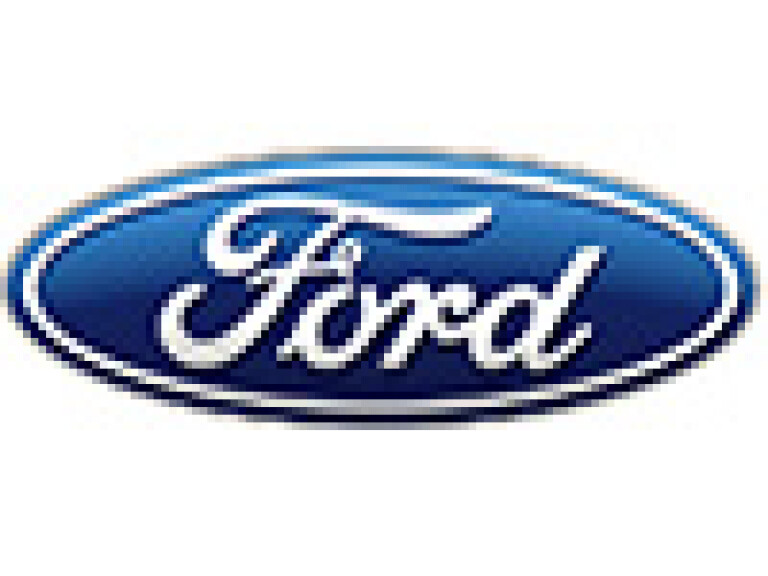
FORD TERRITORY TITANIUM AWD
Price as tested: $63,240
NCAP rating: 5 stars
Fuel economy: 10.3L/100km (test average)
Boot capacity: 523 litres
Plus: Price; sharp handling; beautifully refined; more frugal than petrol six
Minus: Doughy throttle response; slow transmission; old-tech engine
Verdict: 8.5/10

BMW X5 XDRIVE 30D
Price as tested: $92,100/Tested $101,499 *Includes 18in alloys ($1100), panoramic sunroof ($3700), and aluminium running board ($700)
NCAP rating: Not tested
Fuel economy: 10.2L/100km (test average)
Boot capacity: 620 litres
Plus: Punchy, creamy drivetrain; economy; room; on-road handling
Minus: Price; firm ride quality; squirmy on rough dirt roads
Verdict: 8.0/10

COMMENTS